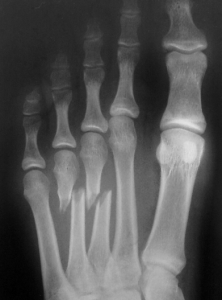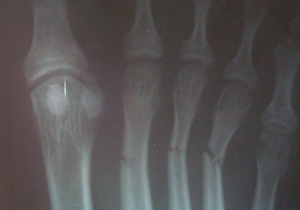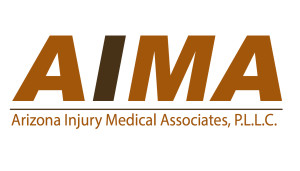Foot Fracture Overview – Metatarsals
Foot fractures can be very disabling injuries, causing pain and significant loss  of mobility. The foot is comprised of several bones and when fractured or broken can cause the person affected to experience a number of symptoms.
of mobility. The foot is comprised of several bones and when fractured or broken can cause the person affected to experience a number of symptoms.
There are five metatarsals within the foot, each highly susceptible to fracture among active adults and children. The first and fifth metatarsals are among the most common fractures. The third and fourth metatarsals (as seen in the image) do not typically require surgery unless there are significant displacements of the bone.
A metatarsal fracture can either be an acute fracture or a stress fracture. The area can be fractured by sudden impact or via repetitive impact and pressure, which leads to stress fracture. For example, the fracture to the right could easily have occurred from someone dropping a heavy object at work, leading to a need for an Arizona Workers Compensation doctor.
Treatment Plan
The typical treatment plan of a metatarsal fracture depends on the nature of the break and its location.
- X-rays of the foot are taken to confirm the fracture site

The fractures seen here are minimally displaced and can be treated nonoperatively.
- If bones are displaced a short cast or boot may be required for several weeks
- X-rays are typically taken again, after approximately six weeks, to confirm healing
- More complex breaks may require surgery
- Rehabilitation may be required
- A gradual return to activities and sports
Symptoms of a Broken Toe
A broken toe can be quite painful, especially following the injury. The most common symptoms displayed by a broken toe include the following:
- Pain at the injury site

- Swelling and inflammation
- Redness
- Appearance of toe may be deformed, bent or crooked
- Difficulty walking due to pain – especially if the large toe is broken
- Bruising of the skin around the toe
Other symptoms of pain may result from wearing shoes that are too tight or become tight due to the swelling that occurs at the injury site. Symptoms may result immediately or within minutes or hours following the injury.
If treatment is not sought right away, a broken toe may result in delayed complications. If the toe fracture heals inappropriately or without treatment, arthritis, stiffness or even deformity may develop. There are rare occasions that a fracture of the toe may not heal  completely, giving rise to a malunion or nonunion. This condition can also cause further complications if the toe is not treated properly.
completely, giving rise to a malunion or nonunion. This condition can also cause further complications if the toe is not treated properly.
If you experience an injury to foot, heel or toe, it is necessary to have the condition examined by a doctor. Careful assessment and x-rays can help identify the problem and relieve your symptoms of pain and discomfort.






Leave A Comment